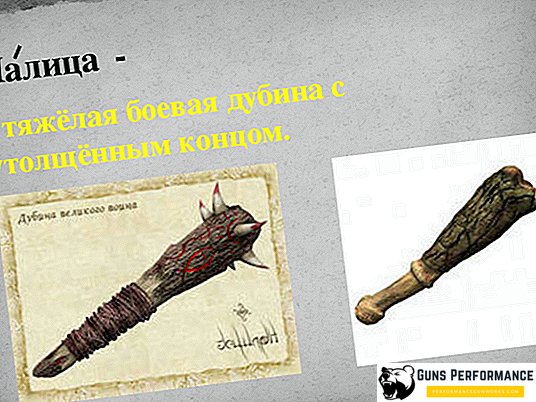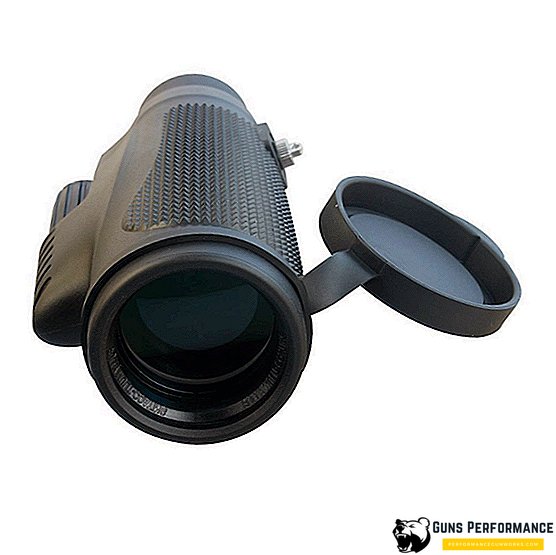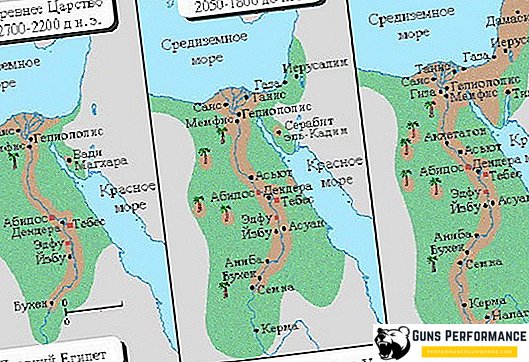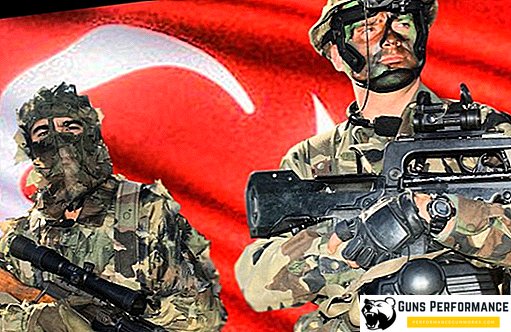
Mace - a weapon with an ancient history. It appeared in the Stone Age and was a transitional form from the simplest club to the battle mace. The club belongs to the group of shock-crushing cold weapons and, with proper strength and skill, is a deadly weapon. Modern varieties of clubs are still used.
Combat Mace - general view and classification

For the manufacture of the club, the hardest wood was chosen, which was available in the area where the warriors lived. The club could be made in several ways:
- The easiest way to manufacture this weapon was that the sapling was uprooted, and its butt served as a percussion element. The presence of knots was welcomed, as it allowed us to hurt the enemy more. Naturally, before using the club was processed to give a more convenient form;
- Another way of making the crown was that a deep incision was made on the trunk of the tree, closer to the butt, into which the stone was inserted. A few years later a tree with an ingrown stone was cut down. Where there was a stone, a thickening was formed, which served as a percussion element;
- More modern samples of this weapon were simply cut from solid wood. The striking part was reinforced with various linings, rings and even small spikes.
The blows inflicted by this weapon had tremendous power, since the parameters of the club were quite impressive. The weight of the club could reach 12 kilograms, and its length - 1.2 meters. Of course, only a real hero could have such a weapon, so the average weight of the club did not exceed 6 kg, with a length of up to one meter.

The heads of any club were always 3-5 times thicker than its handle. Sometimes the pommel of the club could be made of stone or iron, but more often than not, it was simply bound with metal.
There were lighter maces, which were sometimes used for throwing. Such weapons are most often used by horsemen. The mace was usually thrown at the fleeing enemy, since for the rider she was a backup weapon that was used in case of loss of the main one. In addition, light club blows stunned enemies, allowing them to be taken prisoner.
In ancient Russia, there was a two-handed version of the club - an oslops. It was this option that differed in length and weight. Only a warrior with enormous physical strength could have such a weapon. The blows of the ass fell down opponents with their feet, inflicting severe injuries. Often, the osylop was used against riders. The length of this club allowed her to work at a safe distance from the rider, and the blows at the horse guaranteed to knock her down.
The difference between the club and the club
The standard mace is a short-arm weapon. Many people, seeing the club for the first time, can confuse it with a mace. Indeed, often these two types of weapons are very similar to each other. The main difference between them is that the mace is a composite weapon, since it consists of a handle on which the impactor is attached (using an eyelet). The club is always made from a single piece.
Often the mace was wrapped with leather, and thorns were inserted into the top of the head, which could be made of thick nails. To do this, it was necessary to drill holes in the top (otherwise the nails can simply split the club) and not completely hammer the nails into them, from which the caps were then chopped off or grinded.
War maces of various times and peoples

In Africa, still used light maces of the local Masai tribe, which are called "runda". This club is used in local competitions in throwing, and is also sold to tourists as a souvenir. Its striking part stands out sharply and is made in the shape of a ball, often having a specific nose in the form of a bird's beak.
The most difficult versions of the club can be considered a Russian osylop and his Japanese counterpart, a tezubo battle club. Unlike the ass, which was a weapon of commoners, tetsubo did not disdain to use samurai. On the contrary, the Japanese warrior, who possessed the use of the tetsubo technique, was greatly respected, as he had simply bear power.

There was also a lighter Japanese club, which was called kanabo. This club is often used heroes of Japanese legends.
Generally, the use of the club is often found in legends. It was she who was the weapon of the Greek heroes Hercules and Theseus. Even the King of England, William the Conqueror, was often depicted with a light club in his hand.
The clubs of the Indians of North America have an interesting form. Some of them looked like flint-guns of the first settlers. The impact of these batons was similar to the butt. Usually the shock edge of these clubs was crowned with flat spikes made of silicon or obsidian.
Another interesting kind of club was the Indians of the Dakota tribe. It was the so-called "flexible mace." It was made of a bunch of willow twigs tied together. At the end of this club, a heavy round or oval shaped stone was attached.
The medieval warriors of Europe and Asia used iron clubs, with a faceted section of the shock. Due to the edges, the club easily split the heads. Wooden mace in that era used peasants and robbers. This weapon was very popular because it was easy to manufacture and had crushing power.
Fencing schools in Europe and Asia used wooden clubs as weapons for training. Among ordinary citizens and peasants, the club was popular as a weapon for spectacular fights. Many peasants in medieval Europe masterly owned a wooden club.
Although the knightly class despised wooden clubs, knights often participated in peasant tournaments. For the peasants, the participation of a knight in their fun meant not only fun, but also mortal danger. The fact is that the trained knights beat them with all their might, and if the peasant won, then often the proud feudal lord was waiting for him after the tournament, sword in hand.
Knights sometimes also used wooden clubs in their tournaments, but only when ignoble people became their opponents.
Carpathian shepherd's mace

In the Carpathian mountains you can still find an interesting version of the club. This weapon is about two meters long, but has a thickness of about 4 centimeters in diameter. The upper part of the club is bent in the shape of an arc, and the shock part has significant growths from four sides. These growths were obtained because of the cuts, which were made on a growing tree. The top of the tree was tied in the shape of an arc. A few years later, when the tree trunk reached the required length, it was cut down and processed.
Such a club was called "gzrlyga". A hook on one of its parts served to hook the animal by the legs, and even the wolf could be stunned by the shock part. In addition, a garlyga could fight off the robbers. Local old-timers say that before many shepherds owned a similar club, who often used it to resolve conflicts between themselves. Unfortunately, the technique of fighting is now only known by the herrygs, and they are no longer able to repeat some of the techniques of fighting due to old age.
Maces of the peoples of Oceania, Melanesia and the islands of the Fiji archipelago

The clubs of the local Aboriginal people significantly dominate other types of weapons. They are both stone and wood, of various sizes. It was the natives with Fiji who became famous as virtuoso masters of battle on clubs.
The most important military weapon of the islanders is a fighting mace of several types:
- Throwing, which by the method of application is similar to the club of the African Masai tribe. This club was made of solid wood, and the interweaving of the roots at the base served as the finished shock part. The handle of such a baton did not exceed 35 centimeters. In addition to throwing, clubs of this type were used in melee;

- Another variant of the baton was different from the top, which was smooth or carved. Often the pommel maces of this species were equipped with a multitude of spikes protruding in all directions. The entire handle of this weapon was covered with elaborate fine carving, which, apart from the decorative functions, did not allow the hand to slide;
- The islanders held a heavy club for close combat with both hands, it was not suitable for throwing because of its weight. Such a mace had a flat, pointed blade at one end. The club itself is shaped like a paddle. Since the enemy was hit precisely by this edge, this weapon had chopping rather than crushing properties;
- There was another rather exotic version of the club - with cusps at both ends. The technique of fighting with such a stick was very different from using traditional mace. This weapon was held in the middle with two hands. Despite the rather ridiculous appearance, such a mace (in the hands of the master) proved to be more effective than the European saber;
- In addition to these combat samples, there are still many different types of maces, which are a symbol of the power of the leader or are used only in ritual dances. Such samples are real works of art, as they are completely covered with carvings with inlays. In this thread is dominated by the image of the eye and man.

All aboriginal maces are made of hard wood.
There is another Polynesian weapon, which locals call a wooden sword. Although by classification, it is rather a club. Despite the formidable look, such a club was only suitable for a few blows, after which the victorious party restored it for a long time.

The modern version of the club can be found in the homes and cars of many of our compatriots. This is a baseball bat that is not used to play baseball at all.













